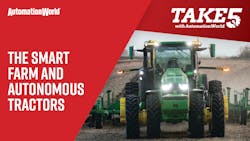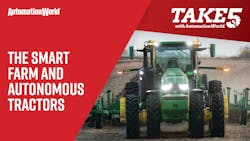
Quick hits:
- John Deere unveils autonomous 8R tractor.
- Fieldin technology digitizes the day-to-day processes of the farm.
- Midnight Robotics Technologies, a maker of a LiDAR-based retrofit kit, can turn any tractor into an autonomous machine.
- Autonomous farms needed in the future to meet a 50% increase in food demand by the year 2050.
Welcome to Take Five with Automation World, I’m Stephanie Neil and today I’m talking about robots and farming, and what this means for consumers and manufacturers.
In Automation World magazine, we’ve covered issues such as IoT on the farm for collecting data on crops, or even cows. And we’ve reported on how to use automation for food safety compliance and tracking food from farm to fork.
Over the years, John Deere is often cited as a company that has been on the forefront of innovation in agriculture. They’ve incorporated sensors and cameras to collect equipment data, as well as provided apps to farmers to access and analyze field operations. They even introduced functions such as AutoTrac turn automation for hands-free guidance of the machine.
But in early January, at the CES 2022 show, John Deere went way beyond hands-free guidance, announcing a major advancement for precision farming. And it’s in the form of a self-driving fully autonomous tractor.
The autonomous 8R tractor was described in a press conference as “one giant robot,” as it is equipped with GPS guidance, six pairs of stereo cameras for a full view into obstacle detection and calculation, and a deep neural network that determines if the tractor should stop when there’s something in its path.
According to the company, the autonomous 8R solves a problem that every farmer, and every manufacturer for that matter, has faced in recent years—and that is the lack of skilled labor. Now, it also makes life easier for the farmer. Everything is controlled from a smartphone, from turning on the tractor to collecting data on how much of the field is tilled, or checking fuel levels of the running machine.
A video of the self-driving tractor in action includes comments from Doug Nimz, a fourth-generation corn and soybean farmer from Minnesota. He said labor is always a challenge because of weather or environmental conditions, and they often need people for many hours in a short amount of time.
He’s quoted as saying: “Autonomy will help, because we’ll be able to put a tractor out in the field and let it run 24 hours a day.”
Now, why does this matter?
Well, soon enough, there will be way more mouths to feed. By 2050 it is predicted that the world’s population will grow from 8 billion people to nearly 10 billion people, increasing food demand by 50%. And farmers are tasked with growing more food on the same amount of land.
Farmers need technology to do more with less. And the autonomous tractor solves a problem. But it only solves part of the problem.
Of course, John Deere is not the only company out there innovating in agriculture. And, the move to an autonomous farm is not solved by one machine.
A company called Fieldin recently acquired Midnight Robotics Technologies, a maker of a LiDAR-based retrofit kit that can turn any tractor into an autonomous machine. Together with its proprietary sensors and data management tools—that can also connect to any machine—Fieldin can start digitizing the day-to-day processes of the farm.
Now, we know as manufacturers, digitized data can transform the way we operate. Having a birds eye, real-time view of all mechanical activity—not just a John Deere tractor—will help farmers understand actual operational costs. And the ability to collect that data to gain visibility leads to industry benchmarking and eventually predictive modeling using artificial intelligence.
And, ultimately, what happens on the farm impacts everything else. According to Deloitte’s 2020 report titled Transforming Agriculture through Digital Technologies, recent technology advances in AI, IoT, cloud computing, and blockchain, in addition to the use of precision farming, robotics, and drones, not only increase production and optimize the use of resources, but also reduce waste and ensure food traceability and quality. And, in the future, we will need an ecosystem approach to succeed that includes each step in the process from growing, processing, distributing, consuming, and recycling.
That’s it for today’s edition of Take Five with Automation World.
